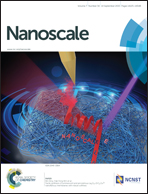Nano-structural characteristics of carbon nanotube–polymer composite films for high-amplitude optoacoustic generation
Abstract
We demonstrate nano-structural characteristics of carbon nanotube (CNT)–polydimethylsiloxane (PDMS) composite films that can be used as highly efficient and robust ultrasound transmitters for diagnostic and therapeutic applications. An inherent architecture of the nano-composite provides unique thermal, optical, and mechanical properties that are accommodated not just for efficient energy conversion but also for extraordinary robustness against pulsed laser ablation. First, we explain a thermoacoustic transfer mechanism within the nano-composite. CNT morphologies are examined to determine a suitable arrangement for heat transfer to the surrounding PDMS. Next, we introduce an approach to enhance optical extinction of the composite films, which uses shadowed deposition of a thin Au layer through an as-grown CNT network. Finally, the transmitter robustness is quantified in terms of laser-induced damage threshold. This reveals that the CNT–PDMS films can withstand an order-of-magnitude higher optical fluence (and extinction) than a Cr film used as a reference. Such robustness is crucial to increase the maximum-available optical energy for optoacoustic excitation and pressure generation. All of these structure-originated characteristics manifest the CNT–PDMS composite films as excellent optoacoustic transmitters for high-amplitude and high-frequency ultrasound generation.


 Please wait while we load your content...
Please wait while we load your content...